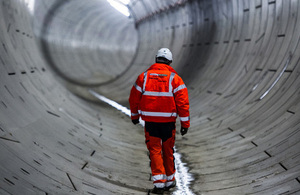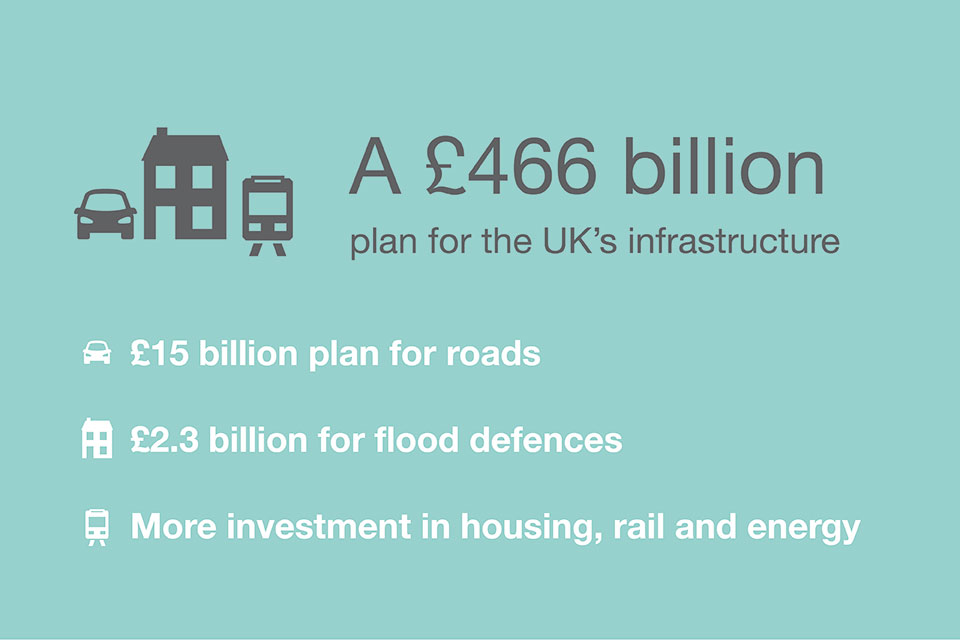Ambitious plans for housing, flood defence and roads set out in National Infrastructure Plan 2014
A radical new approach to housing, £2.3 billion of investment in flood defences and £15 billion of road improvements

National Infrastructure Plan 2014 published
A radical new approach to housing, £2.3 billion of investment in flood defences and £15 billion of road improvements were set out today (2 December 2014) as the government launched the National Infrastructure Plan 2014.
One of the key proposals is for the government to master-plan, directly commission, build and even sell homes. A pilot programme on a government-owned former RAF base in Northstowe, near Cambridge, will see the Homes and Communities Agency leading development of 10,000 homes, twice as fast as conventional approaches. This is the first time in a generation that the government has owned land, led a development on it at this scale, and considered commissioning homes directly for sale. This approach will fast track the development by providing certainty making new homes available more quickly.
The government will make an upfront investment but expects that later costs will be met through the sale of land and homes. The government will also evaluate the feasibility and economic impacts of rolling out this model on a wider scale, to support and accelerate housing supply.

The National Infrastructure Plan, launched at the Institution of Civil Engineers, also sets out the progress made on previously announced major housing and regeneration schemes, including the first £100 million investment to provide infrastructure and land remediation at Ebbsfleet, taking forward the government’s commitment to the first new garden city for almost 100 years, delivering up to 15,000 new homes. Additionally, it includes a commitment to a heads of terms agreement for a loan of £55 million to support the extension of the London Overground to Barking Riverside, to unlock the delivery of 11,000 homes; and supporting the regeneration of Brent Cross subject to a business case, to unlock 7,500 homes. Today the government is also extending the capital settlement for affordable housing by £957 million in 2018-19 and 2019-20 to ensure that 275,000 new affordable homes can be delivered over the next Parliament.
The plan also commits to £2.3 billion of capital investment to over 1400 flood defence projects in an unprecedented 6-year programme of investment. As a result, over 300,000 homes will be better protected and over £30 billion of economic damages prevented. Major projects that will benefit include £42 million for Oxford Flood Alleviation Scheme, £80 million for the Humber Estuary and over £17 million for Tonbridge, Yalding and the surrounding communities.
In addition, the government has committed to spend £15.5 million in Somerset on flood defences over the next 6 years benefitting 7,000 properties, including £4.2 million on the Somerset Levels and Moors.
On roads, the plan outlines the biggest package of improvements undertaken in the modern age including £15 billion of investment which will triple levels of spending by the end of the decade. Over 1,300 new lane miles will be added over the next parliament on motorways and trunk roads tackling congestion and fixing some of the most notorious and longstanding problem areas on the network like the A303, A1, A47 and A27.
The plan also reports on progress on infrastructure investment and delivery since 2010. It concludes that over 2500 different projects or schemes have been delivered including 55 major roads and transport schemes, over 500 flood and coastal erosion defence improvements, 20GW of new electricity generation capacity created and 1.5 million homes provided with access to superfast broadband for the first time.
Overall £460 billion worth of public and private investment to the end of the decade and beyond is planned across the key infrastructure sectors and average annual investment is 15% higher in this Parliament than it was in the previous Parliament, increasing from £41 billion between 2005 and 2010 to £47 billion between 2011 and 2014.
Chief Secretary to the Treasury, Danny Alexander said:
This plan sets out £400 billion of infrastructure investment in public and private projects that will help to create a stronger, more balanced economy and a fairer society.
Good quality infrastructure is vital for the economic well-being of this country. Every part of the country needs to be able to move people, goods, data and power, quickly and easily, and to protect itself from flooding. That is what our pioneering focus on better infrastructure seeks to achieve.
New houses support economic growth and are a crucial element of a fair society, so I’ve prioritised the investment of almost £2 billion to ensure we can build on average 55,000 new homes a year until 2020. Combined with the other measures we are announcing today, we will vastly increase supply by providing funding certainty, unlocking capacity in housing associations and kick starting stalled regeneration projects.
Commercial Secretary to the Treasury, Lord Deighton said:
The fifth National Infrastructure Plan shows that the government is delivering on infrastructure, with a long term strategy to make sure the UK tackles decades of underinvestment and gives us the infrastructure we need to compete in the 21st century.
Investment is increasing to around £460 billion over the coming years, with 64% of our prospective infrastructure projects and programmes already underway. As part of our long-term economic plan, we’ve set out government priorities with clear delivery milestones and reformed planning rules to drive forward the most important projects. We are making sure we are building the strong, modern economy of the future.
The measures supporting housing in the National Infrastructure Plan will be accompanied by a package of measures also being announced today to increase access to affordable housing. These include:
- working with Bicester to support its plans to become a garden town, to support the construction of up to 13,000 homes
- consulting on streamlining the process for selling shared ownership properties
- approval of London’s Grahame Park, Blackwall Reach, Aylesbury Estate and New Union Wharf projects for funding under the £150 million estates regeneration programme, subject to due diligence and contract negotiations, where 8,000 homes will be built
- committing to release public sector land with capacity for up to 150,000 homes over the next Parliament
- consulting on ways to increase the borrowing capacity of housing associations in relation to the valuation of properties transferred from local authorities
Nick Baveystock, Institution of Civil Engineers (ICE) Director General, said:
The National Infrastructure Plan is a vehicle for improved visibility and stability for industry, enabling earlier planning and investment in developing the UK’s skills and capacity. To retain confidence, the NIP must continue to evolve, and I am pleased therefore to see a fifth iteration.
Government should build on this further as we move towards the General Election, with the focus of the plan continuing to move towards delivery. The more projects we see that are packaged up with clear funding streams and ‘shovel-ready’, the better the industry can help generate long-term economic growth. Investors and industry will also need to see consistent commitment from all political parties.
Anna Stewart, Chief Executive of Laing O’Rourke, said:
Long-term visibility of the government’s approach to infrastructure is a crucial factor in our own ability to plan for the future. The National Infrastructure Plan, and the detailed project pipeline, gives us the confidence to invest and ensure we have the highly skilled workforce to deliver the roads, rail and power networks that this country needs.
Updates to this page
-
added link to infographic
-
First published.